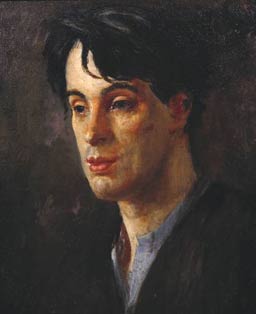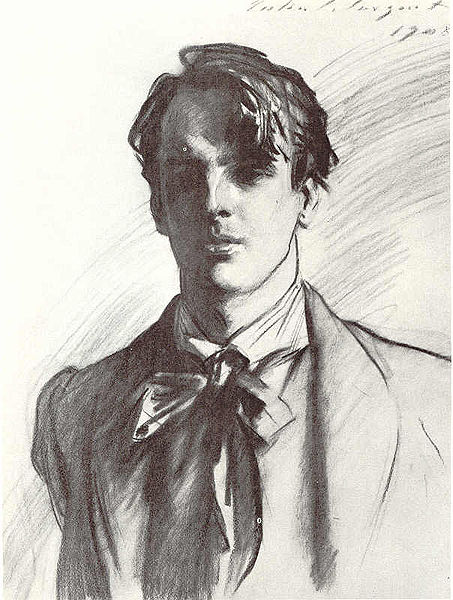<Back to Index>
- Physicist James Clerk Maxwell, 1831
- Author William Butler Yeats, 1865
- Holy Roman Emperor Charles the Bald, 823
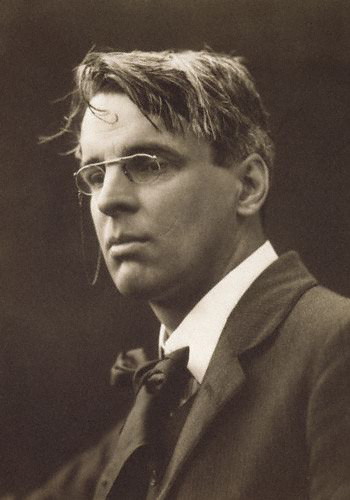
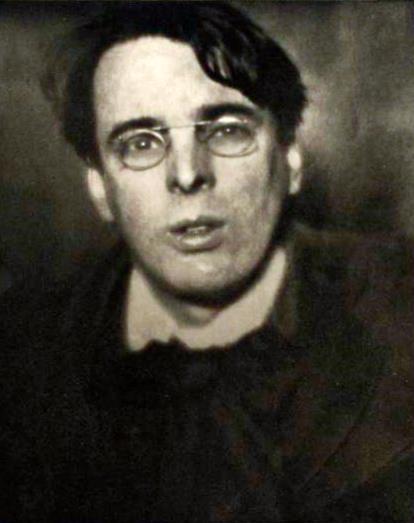
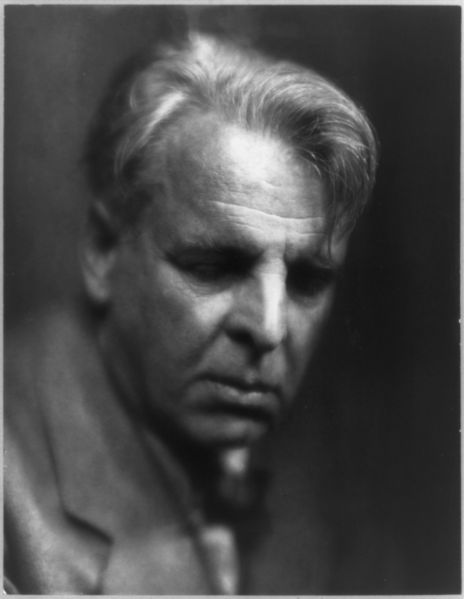
William Butler Yeats (13 June 1865 – 28 January 1939) was an Irish poet, dramatist, and one of the foremost figures of 20th century literature. A pillar of both the Irish and British literary establishments, in his later years Yeats served as an Irish Senator for two terms. He was a driving force behind the Irish Literary Revival, and along with Lady Gregory and Edward Martyn founded the Abbey Theatre, serving as its chief during its early years. In 1923, he was awarded the Nobel Prize in Literature for what the Nobel Committee described as "inspired poetry, which in a highly artistic form gives expression to the spirit of a whole nation." He was the first Irishman so honored. Yeats is generally considered one of the few writers whose greatest works were completed after being awarded the Nobel Prize; such works include The Tower (1928) and The Winding Stair and Other Poems (1929).
Yeats was born and educated in Dublin but spent his childhood in County Sligo.
He studied poetry in his youth, and from an early age was fascinated by
both Irish legends and the occult. Those topics feature in the first
phase of his work, which lasted roughly until the turn of the century.
His earliest volume of verse was published in 1889, and those slowly
paced and lyrical poems display debts to Edmund Spenser and Percy Bysshe Shelley, as well as to the lyricism of the Pre-Raphaelite poets.
From 1900, Yeats' poetry grew more physical and realistic. He largely
renounced the transcendental beliefs of his youth, though he remained
preoccupied with physical and spiritual masks, as well as with cyclical
theories of life. Over the years, Yeats adopted many different
ideological positions, including, in the words of the critic Michael
Valdez Moses, "those of radical nationalist, classical liberal,
reactionary conservative and millenarian nihilist". William Butler Yeats was born in Sandymount, County Dublin, Ireland. His father, John Butler Yeats, was a descendant of Jervis Yeats, a Williamite soldier and linen merchant who died in 1712. Jervis' grandson Benjamin married Mary Butler, daughter of a landed family in County Kildare.
At the time of his marriage, John Yeats was studying law but abandoned
his studies to study art at Heatherley’s Art School in London. His mother, Susan Mary Pollexfen, came from a wealthy Anglo-Irish family in County Sligo who owned a prosperous milling and shipping business. Soon after William's birth the family relocated to Sligo to
stay with her extended family, and the young poet came to think of the
area as his childhood and spiritual home. Its landscape became, over
time, both literally and symbolically, his "country of the heart". The Butler Yeats family were highly artistic; his brother Jack went on to be a highly regarded painter, while his sisters Elizabeth and Susan Mary — known to family and friends as Lollie and Lily — became involved in the Arts and Crafts movement. Yeats grew up as a member of the former Protestant Ascendancy at
the time undergoing a crisis of identity. While his family was broadly
supportive of the changes Ireland was experiencing, the nationalist
revival of the late 19th century directly disadvantaged his heritage,
and informed his outlook for the remainder of his life. In 1997, his
biographer R.F. Foster observed that Napoleon's dictum that to
understand the man you have to know what was happening in the world
when he was twenty "is manifestly true of W.B.Y." Yeats'
childhood and young adulthood were shadowed by the power shift away
from the minority Protestant Ascendancy. The 1880s saw the rise of Parnell and the Home rule movement, the 1890s the momentum of nationalism, while the Catholics became
prominent around the turn of the century. These developments were to
have a profound effect on his poetry, and his subsequent explorations
of Irish identity had a significant influence on the creation of his
country's biography.
In
1876, the family moved to England to aid their father, John, to further
his career as an artist. At first the Yeats children were educated at
home. Their mother entertained them with stories and Irish folktales.
John provided an erratic education in geography and chemistry, and took William on natural history explorations of the nearby Slough countryside. On 26 January 1877, the young poet entered the Godolphin primary school, which
he attended for four years. He did not distinguish himself
academically, and an early school report describes his performance as
"only fair. Perhaps better in Latin than in any other subject. Very
poor in spelling." Though he had difficulty with mathematics and languages (possibly because Yeats was tone deaf),
he was fascinated by biology and zoology. For financial reasons, the
family returned to Dublin toward the end of 1880, living at first in
the city centre and later in the suburb of Howth. In October 1881, Yeats resumed his education at Dublin's Erasmus Smith High School. His
father's studio was located nearby and William spent a great deal of
time there, and met many of the city's artists and writers. It was
during this period that he started writing poetry, and, in 1885, Yeats'
first poems, as well as an essay entitled "The Poetry of Sir Samuel Ferguson", were published in the Dublin University Review. Between 1884 & 1886, William attended the Metropolitan School of Art — now the National College of Art and Design — in Thomas Street. His first known works were written when he was seventeen, and include a poem heavily influenced by Percy Bysshe Shelley which
describes a magician who set up his throne in central Asia. Other
pieces from this period are a draft of a play involving a Bishop, a
monk, and a woman accused of paganism by local shepherds, as well as
love-poems and narrative lyrics on medieval German knights. The early
works were both conventional and according to the critic Charles Johnson "utterly unIrish", seeming to come out of a "vast murmurous gloom of dreams". Although Yeats' early works drew heavily on Shelley, Edmund Spenser, and on the diction and colouring of pre-Raphaelite verse, he soon turned to Irish myth and folklore and the writings of William Blake.
In later life, Yeats paid tribute to Blake by describing him as one of
the "great artificers of God who uttered great truths to a little clan". In
1891, Yeats published "John Sherman" and "Dhoya", one was a
novella; the other, a story; and both were among the
earliest of his published compositions. The two were re-published
together in 1990 by The Lilliput Press in Dublin. The family returned to London in 1887. In 1890, Yeats co-founded the Rhymers' Club with Ernest Rhys, a
group of London based poets who met regularly in a Fleet Street tavern
to recite their verse. The collective later became known as the "Tragic
Generation" and published two anthologies: first in 1892 and again in 1894. He collaborated with Edwin Ellis on
the first complete edition of William Blake's works, in the process
rediscovering a forgotten poem "Vala, or, the Four Zoas". In a late essay on Shelley, Yeats wrote, "I have re-read Prometheus Unbound... and it seems to me to have an even more certain place than I had thought among the sacred books of the world." Yeats had a life-long interest in mysticism, spiritualism, occultism, and astrology. He read extensively on the subjects throughout his life, became a member of the paranormal research organization "The Ghost Club" (in 1911) and was especially influenced by the writings of Emanuel Swedenborg.
As early as 1892, he wrote: "If I had not made magic my constant study
I could not have written a single word of my Blake book, nor would The Countess Kathleen ever have come to exist. The mystical life is the centre of all that I do and all that I think and all that I write." His
mystical interests — also inspired by a study of Hinduism, under the
Theosophist Mohini Chatterjee, and the occult — formed much of the basis
of his late poetry. However, some critics have dismissed these
influences as lacking in intellectual credibility. In particular, W. H. Auden criticized
this aspect of Yeats' work as the "deplorable spectacle of a grown man
occupied with the mumbo-jumbo of magic and the nonsense of India." Yeats' first significant poem was "The Isle of Statues", a fantasy work that took Edmund Spenser for its poetic model. The piece appeared in Dublin University Review, but has not since been republished. His first solo publication was the pamphlet Mosada: A Dramatic Poem (1886), which comprised a print run of 100 copies paid for by his father. This was followed by the collection The Wanderings of Oisin and Other Poems (1889),
which arranged a series of verse that dated as far back as the
mid-1880s. The long titular poem contains, in the words of his
biographer R.F. Foster, "obscure Gaelic names, striking repetitions
[and] an unremitting rhythm subtly varied as the poem proceeded through its three sections". "The Wanderings of Oisin" is based on the lyrics of the Fenian Cycle of Irish mythology and displays the influence of both Sir Samuel Ferguson and the Pre-Raphaelite poets. The poem took two years to complete and was one of the few works from this period that he did not disown in his maturity. Oisin introduces
what was to become one of his most important themes: the appeal of the
life of contemplation over the appeal of the life of action. Following
the work, Yeats never again attempted another long poem. His other
early poems, which are meditations on the themes of love or mystical
and esoteric subjects, include Poems (1895), The Secret Rose (1897), and The Wind Among the Reeds (1899). During
1885, Yeats was involved in the formation of the Dublin Hermetic Order.
The society held its first meeting on 16 June, with Yeats acting as its
chairman. The same year, the Dublin Theosophical lodge was opened in
conjunction with Brahmin Mohini Chatterjee, who travelled from the Theosophical Society in London to lecture. Yeats attended his first séance the following year. He later became heavily involved with the Theosophical Society and with hermeticism, particularly with the eclectic Rosicrucianism of the Golden Dawn. During séances held from 1912, a spirit calling itself "Leo Africanus" apparently claimed to be Yeats' Daemon or anti-self, inspiring some of the speculations in Per Amica Silentia Lunae. He was admitted into the Golden Dawn in March 1890 and took the magical motto Daemon est Deus inversus — translated as Devil is God inverted or A demon is a god reflected. He was an active recruiter for the sect's Isis-Urania temple, and brought in his uncle George Pollexfen, Maud Gonne, and Florence Farr.
Although he reserved a distaste for abstract and dogmatic religions
founded around personality cults, he was attracted to the type of
people he met at the Golden Dawn. He was involved in the Order's power struggles, both with Farr and Macgregor Mathers, but was most notably involved when Mathers sent Aleister Crowley to
repossess Golden Dawn paraphernalia during the "Battle of Blythe Road".
After the Golden Dawn ceased and splintered into various offshoots, Yeats remained with the Stella Matutina until 1921.
In 1889, Yeats met Maud Gonne, then a 23-year-old heiress and ardent Nationalist. Gonne was eighteen months younger than Yeats and later claimed she met the poet as a "paint-stained art student." Gonne
had admired "The Isle of Statues" and sought out his acquaintance.
Yeats developed an obsessive infatuation with her beauty and outspoken
manner, and she was to have a significant and lasting effect on his
poetry and his life thereafter. In
later years he admitted "it seems to me that she [Gonne] brought into
my life those days — for as yet I saw only what lay upon the surface — the
middle of the tint, a sound as of a Burmese gong, an over-powering
tumult that had yet many pleasant secondary notes." Yeats' love remained unrequited, in part due to his reluctance to participate in her nationalist activism. His
only other love affair during this period was with Olivia Shakespear,
whom he had first met in 1896, and parted with one year later. In 1891,
he visited Gonne in Ireland and proposed marriage, but was rejected. He
later admitted that from that point "the troubling of my life began". Yeats
proposed to Gonne three more times: in 1899, 1900 and 1901. She refused
each proposal, and in 1903, to his horror, married the Irish nationalist Major John MacBride. Yeats' friendship with Gonne persisted, and, in Paris, in 1908, they finally consummated their relationship. "The
long years of fidelity rewarded at last" was how another of his lovers
described the event. Yeats was less sentimental and later remarked that
"the tragedy of sexual intercourse is the perpetual virginity of the
soul." The
relationship did not develop into a new phase after their night
together, and soon afterwards Gonne wrote to the poet indicating that
despite the physical consummation, they could not continue as they had
been: "I have prayed so hard to have all earthly desire taken from my
love for you & dearest, loving you as I do, I have prayed & I
am praying still that the bodily desire for me may be taken from you
too." By
January 1909, Gonne was sending Yeats letters praising the advantage
given to artists who abstain from sex. Nearly twenty years later, Yeats
recalled the night with Gonne in his poem "A Man Young and Old":
My arms are like the twisted thorn In 1896, Yeats was introduced to Lady Gregory by their mutual friend Edward Martyn.
Gregory encouraged Yeats' nationalism, and convinced him to continue
focusing on writing drama. Although he was influenced by French Symbolism,
Yeats concentrated on an identifiably Irish content and this
inclination was reinforced by his involvement with a new generation of
younger and emerging Irish authors. Together with Lady Gregory, Martyn,
and other writers including J.M. Synge, Sean O'Casey, and Padraic Colum, Yeats was one of those responsible for the establishment of the "Irish Literary Revival" movement. Apart
from these creative writers, much of the impetus for the Revival came
from the work of scholarly translators who were aiding in the discovery
of both the ancient sagas and Ossianic poetry and the more recent folk
song tradition in Irish. One of the most significant of these was Douglas Hyde, later the first President of Ireland, whose Love Songs of Connacht was widely admired. In 1899, Yeats, Lady Gregory, Edward Martyn, and George Moore established the Irish Literary Theatre for the purpose of performing Celtic and Irish plays. The
ideals of the Abbey were derived from the avant-garde French theatre,
which sought to express the "ascendancy of the playwright rather than
the actor-manager à l'anglais." The
group's manifesto, which Yeats himself wrote, declared "We hope to find
in Ireland an uncorrupted & imaginative audience trained to listen
by its passion for oratory... & that freedom to experiment which is
not found in the theatres of England, & without which no new
movement in art or literature can succeed." The
collective survived for about two years and was not successful.
However, working together with two Irish brothers with theatrical
experience, William and Frank Fay, Yeats' unpaid yet independently wealthy secretary Annie Elizabeth Fredericka Horniman, and the leading West End actress Florence Farr,
the group established the Irish National Theatre Society. This group of
founders was able, along with J.M. Synge, to acquire property in Dublin
and open the Abbey Theatre on 27 December, 1904. Yeats' play Cathleen Ní Houlihan and Lady Gregory's Spreading the News were
featured on the opening night. Yeats continued to be involved with the
Abbey until his death, both as a member of the board and a prolific
playwright. In 1902, he helped set up the Dun Emer Press to publish work by writers associated with the Revival. This became the Cuala Press in 1904, and inspired by the Arts and Crafts movement, sought to "find work for Irish hands in the making of beautiful things." From
then until its closure in 1946, the press — which was run by the poet's
sisters — produced over 70 titles; 48 of them books by Yeats himself. In 1913, Yeats met the American poet Ezra Pound.
Pound had travelled to London at least partly to meet the older man,
whom he considered "the only poet worthy of serious study." From that year until 1916, the two men wintered in the Stone Cottage at Ashdown Forest, with Pound nominally acting as Yeats' secretary. The relationship got
off to a rocky start when Pound arranged for the publication in the
magazine Poetry of
some of Yeats' verse with Pound's own unauthorised alterations. These
changes reflected Pound's distaste for Victorian prosody. A more
indirect influence was the scholarship on Japanese Noh plays that Pound had obtained from Ernest Fenollosa's
widow, which provided Yeats with a model for the aristocratic drama he
intended to write. The first of his plays modelled on Noh was At the Hawk's Well, the first draft of which he dictated to Pound in January 1916. In
his early work, Yeats' aristocratic pose led to an idealisation of the
Irish peasant and a willingness to ignore poverty and suffering.
However, the emergence of a revolutionary movement from the ranks of
the urban, mostly Roman Catholic lower-middle class made him reassess
his attitudes. His new direct engagement with politics can be seen in
the poem September 1913,
with its well-known refrain "Romantic Ireland's dead and gone / It's
with O'Leary in the grave." The poem is an attack on the Dublin
employers who were involved in the 1913 Dublin Lockout of workers, and it supports James Larkin's attempts to organise the Irish labour movement. In the refrain of "Easter 1916"
("All changed, changed utterly / A terrible beauty is born"), Yeats
faces his own failure to recognise the merits of the leaders of the Easter Rising, due to his attitude towards their humble backgrounds and lives.
By
1916, Yeats was 51 years old and determined to marry and produce an
heir. His final proposal to Maud Gonne took place in the summer of 1916. In
his view, Gonne's history of revolutionary political activism, as well
as a series of personal catastrophes in the previous few years of her
life, including chloroform addiction and a troubled marriage to John MacBride — an Irish revolutionary who was later executed by British forces for his role in the 1916 Easter Rising — made her an unsuitable wife. Biographer
R.F. Foster has observed that Yeats' last offer was motivated more by a
sense of duty than by a genuine desire to marry Gonne. Yeats
made his proposal in an indifferent manner, with conditions attached,
and he both expected and hoped to be turned down. According to Foster
"when he duly asked Maud to marry him, and was duly refused, his
thoughts shifted with surprising speed to her daughter". Iseult Gonne was Maud's second child with Lucien Millevoye,
and at the time was twenty-one years old. She had lived a sad life to
this point; conceived as an attempt to reincarnate her short-lived
brother, for the first few years of her life, she was presented as her
mother's adopted niece. She was molested by her stepfather when she was
eleven, and later worked as a gunrunner for the Irish Republican Army. At fifteen, she proposed to Yeats. A few months after the poet's approach to Maud, he proposed to Iseult, but was rejected.
That
September, Yeats proposed to twenty-four year old George (Georgie)
Hyde-Lees (1892–1968), whom he had met through occult circles. Despite
warning from her friends — "George ... you can't. He must be
dead" — Hyde-Lees accepted, and the two were married on 20 October. Their
marriage was a success, in spite of the age difference, and in spite of
Yeats' feelings of remorse and regret during their honeymoon. The
couple went on to have two children, Anne and Michael.
Although in later years he had romantic relationships with other women
and possibly affairs, George herself wrote to her husband "When you are
dead, people will talk about your love affairs, but I shall say
nothing, for I will remember how proud you were."
During the first years of his marriage, he and George engaged in a form of automatic writing,
which involved George contacting a variety of spirits and guides, which
they termed "Instructors". The spirits communicated a complex and
esoteric system of characters and history which they developed during
experiments with the circumstances of trance and the exposition of
phases, cones, and gyres. Yeats devoted much time to preparing this material for publication as A Vision (1925).
In 1924, he wrote to his publisher T. Werner Laurie admitting: "I dare
say I delude myself in thinking this book my book of books".
In
December 1923, Yeats was awarded the Nobel Prize in Literature, and was
determined to make the most of the occasion. He was aware of the
symbolic value of an Irish winner so soon after Ireland had gained
independence, and sought to highlight the fact at each available
opportunity. His reply to the many of the letters of congratulations
sent to him contained the words: "I consider that this honor has come
to me less as an individual than as a representative of Irish
literature, it is part of Europe's welcome to the Free State." Yeats
used the occasion of his acceptance lecture at the Royal Academy of
Sweden to present himself as a standard-bearer of Irish nationalism and
Irish cultural independence. As he remarked, "The theatres of Dublin
were empty buildings hired by the English travelling companies, and we
wanted Irish plays and Irish players. When we thought of these plays we
thought of everything that was romantic and poetical, because the
nationalism we had called up — the nationalism every generation had
called up in moments of discouragement — was romantic and poetical." The prize led to a significant increase in the sales of his books, as his publishers Macmillan sought
to capitalise on the publicity. For the first time he had money, and he
was able to repay not only his own debts, but those of his father.
By early 1925, Yeats's health had stabilized, and he had completed most of the writing for "A Vision"
(dated 1925, it actually appeared in January 1926, when he almost
immediately started rewriting it for a second version). He had been
appointed to the first Irish Senate in 1922, and was re-appointed for a second term in 1925. Early
in his tenure, a debate on divorce arose, and Yeats viewed the issue as
primarily a confrontation between the emerging Roman Catholic ethos and
the Protestant minority. When the Roman Catholic Church weighed in with a blanket refusal to consider their anti position, the Irish Times countered that a measure to outlaw divorce would alienate Protestants and "crystallize" the partition of Northern Ireland. In
response, Yeats delivered a series of speeches in which he attacked the
"quixotically impressive" ambitions of the government and clergy,
likening their campaign tactics to that of "medieval Spain". "Marriage
is not to us a Sacrament, but, upon the other hand, the love of a man
and woman, and the inseparable physical desire, are sacred. This
conviction has come to us through ancient philosophy and modern
literature, and it seems to us a most sacrilegious thing to persuade
two people who hate each other...to live together, and it is to us no
remedy to permit them to part if neither can re-marry." The
resulting debate has been described as one of Yeats's "supreme public
moments", and began his ideological move away from pluralism towards
religious confrontation. His
language became more forceful; the Jesuit Father Peter Finlay was
described by Yeats as a man of "monstrous discourtesy", and he lamented
that, "It is one of the glories of the Church in which I was born that
we have put our Bishops in their place in discussions requiring
legislation". During
his time in the Senate, Yeats further warned his colleagues: "If you
show that this country, southern Ireland, is going to be governed by
Roman Catholic ideas and by Catholic ideas alone, you will never get the North...You will put a wedge in the midst of this nation". He memorably said of his fellow Irish Protestants, "we are no petty people".
In 1924, he chaired a coinage committee charged with selecting a set of designs for the first currency of the Irish Free State.
Aware of the symbolic power latent in the imagery of a young state's
currency, he sought a form that was "elegant, racy of the soil, and
utterly unpolitical". When the house finally decided on the artwork of Percy Metcalfe, Yeats was pleased, though he regretted that compromise had led to "lost muscular tension" in the finally depicted images. He retired from the Senate in 1928 due to ill health. Towards the end of his life — and especially after the Wall Street Crash and Great Depression,
which led some to question whether democracy would be able to cope with
deep economic difficulty — Yeats seems to have returned to his
aristocratic sympathies. During the aftermath of the First World War,
he became sceptical about the efficacy of democratic government, and
anticipated political reconstruction in Europe through totalitarian
rule. His later association with Pound drew him towards Benito Mussolini, for whom he expressed admiration on a number of occasions. He wrote three "marching songs" — never used — for the Irish General Eoin O'Duffy's Blueshirts. However, when Pablo Neruda invited
him to visit Madrid in 1937, Yeats responded with a letter supporting
the Republic against Fascism, and he distanced himself from Fascism in
the last years of his life. After undergoing the Steinach operation (vasectomy) in 1934, when aged 69, he found a new vigour evident from both his poetry and his intimate relations with younger women. During this time, Yeats was involved in a number of romantic affairs with, among others, the poet and actress Margot Ruddock, and the novelist, journalist and sexual radicalist Ethel Mannin. As
in his earlier life, Yeats found erotic adventure conducive to his
creative energy, and, despite age and ill-health, he remained a
prolific writer. In a letter of 1935, Yeats noted: "I find my present
weakness made worse by the strange second puberty the operation has
given me, the ferment that has come upon my imagination. If I write
poetry it will be unlike anything I have done". In 1936, he undertook editorship of the Oxford Book of Modern Verse, 1892–1935. He died at the Hôtel Idéal Séjour, in Menton, France, on 28 January 1939. He was buried after a discreet and private funeral at Roquebrune-Cap-Martin. Yeats and George had often discussed his death, and his express wish
was to be buried quickly in France with a minimum of fuss. According to
George, "His actual words were 'If I die bury me up there [at
Roquebrune] and then in a year's time when the newspapers have
forgotten me, dig me up and plant me in Sligo'." In September 1948, Yeats' body was moved to Drumcliffe, County Sligo, on the Irish Naval Service corvette LÉ Macha. His epitaph is taken from the last lines of "Under Ben Bulben", one of his final poems: Cast a cold Eye
And yet there beauty lay;
The first of all the tribe lay there
And did such pleasure take;
She who had brought great Hector down
And put all Troy to wreck.
On Life, on Death.
Horseman, pass by.
